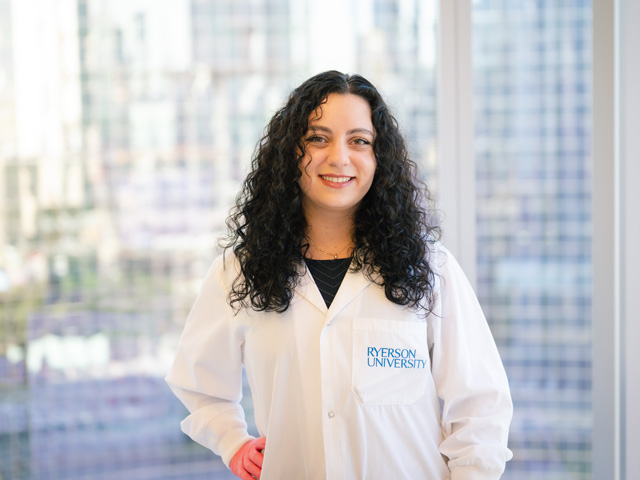Advancing our knowledge of the most common fatal disease among young Canadians

Melissa Iazzi, Molecular Science PhD candidate
Cystic fibrosis is a progressive genetic disorder that causes lung infections, with 90% of patients dying from end-stage obstructive lung failure. As the most common fatal disease affecting young Canadians, third-year molecular science PhD candidate Melissa Iazzi has focused her research on the cystic fibrosis-causing gene CFTR. In particular, she is using BioID to map direct and indirect protein-to-protein interactions in living cells. This novel technique will allow her to map the CFTR interaction network and examine how patient mutations and current frontline CF drugs modify this network.
“Think of these interaction maps as a human social network,” she explains. “When I am interacting with my normal group of friends, I am happy. However, if one of these friendships or interactors were to change, I may begin to express ‘abnormal’ emotions such as sadness or anger. This is the same for CFTR. In normal conditions, CFTR interacts with a number of different friendly proteins. However, upon mutation, some of these ‘friends’ can potentially change or be altered. Just as I experience sadness upon the loss of a friendship, CFTR experiences symptoms of the disease cystic fibrosis.”
Under the supervision of Dr. Gagan Gupta of the Department of Chemistry and Biology, Iazzi is working to fill in gaps in medical knowledge of how CFTR is synthesized and processed and how it is regulated and functions at the apical membrane, which is part of a cell’s surface.
“CFTR associates with a number of proteins that facilitate its trafficking or function, but our understanding of these interactions and how they are altered in CF is relatively poor. Furthermore, it is likely that additional proteins associate with CFTR.”
Iazzi’s combining of affinity-purification mass spectrometry (AP-MS) with proximity labelling techniques such as BioID is a novel and effective means of mapping stable and transient protein-to-protein interactions in living cells. Using BioID to map the CFTR interactome and examine how patient mutations and current frontline CF therapeutics modify this interactome, her research has the potential for both clinical and industrial impact.
“We can identify new candidate proteins that need to be targeted in order to better help patients receive a clinical benefit to the therapies currently approved and available to them,” says Iazzi. “We also hope to draw attention to less studied mutations, as only very few are actually studied. With new screening technologies, we hope to identify new drug targets which can be expanded to lung diseases outside of CF.”
Iazzi recently presented her research at the 2021 European Cystic Fibrosis Conference, at which she was recognized with the Young Investigators Award (external link) . The award commends the quality of work conducted by researchers under the age of 35 and includes a monetary grant.
Having earned recognition from international experts in all fields of CF research, Iazzi is even more excited to pursue the next stage of her research: generating a new 3D modelling screening technique that could expand existing knowledge of most lung diseases. She also hopes to advance understanding of how patients with bacterial infections—a major problem in the CF population—are impacted on a molecular level when thinking in terms of protein-to-protein interactions.
Yet despite her successes in the lab and international recognition, Iazzi may be most proud of her personal development as a student and researcher.
“I came into the program with little wet lab experience and a strong background in statistics,” she says. “Things that may have come easily to a graduate student with a more direct training in the field were definitely challenges for me. But I think I am living testament that you can do anything you put your mind to—with the support of great people, like Dr. Gupta. I can now generate data here at Ryerson that I never thought was possible.”